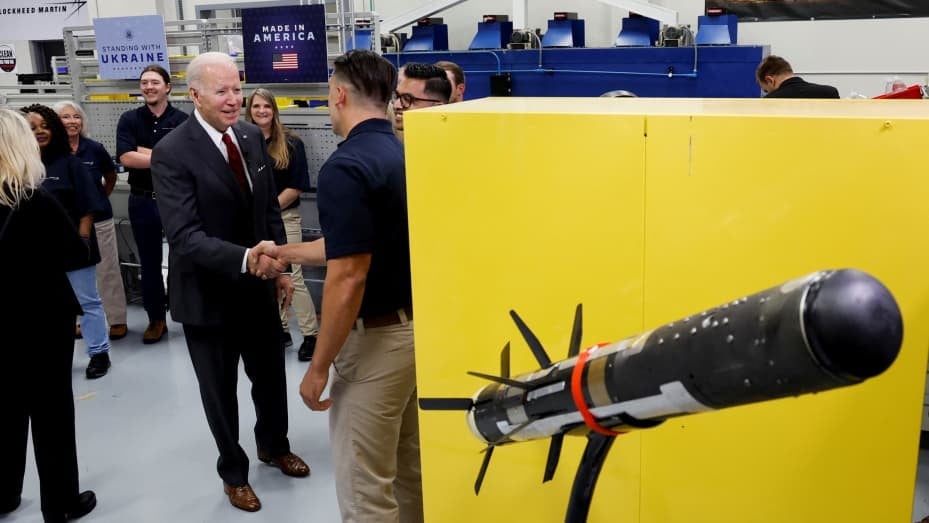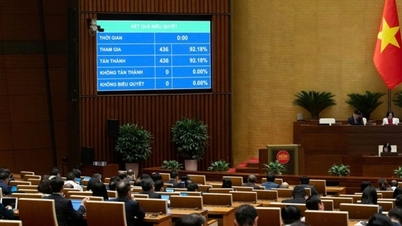 |
| U.S. President Joe Biden visits the Lockheed Martin plant in Troy, Alabama, where Javelin missiles supplied to Ukraine are manufactured, on May 3, 2022. (Source: AP) |
“To any country, any organization, anyone who thinks of taking advantage of the situation, I have only one word: Don’t. Our hearts may be broken, but our resolve is clear,” the American leader warned other parties in the region against seeking to “exploit” the conflict.
Immediately on October 10th, the first plane carrying American ammunition for Israeli attacks on the Gaza Strip landed in Israel.
Leaving aside the complex political situation, and looking at the matter from a different perspective, it is evident that this rapid provision of military aid demonstrates that American military-industrial contractors will once again benefit most from a conflict in the Middle East, just as is happening with the Russia-Ukraine conflict and other past instabilities.
Let's look at the performance of some US defense stocks this week. Lockheed Martin shares rose nearly 9% on October 9th, the biggest gain for America's largest defense contractor since March 2020. Northrop Grumman shares also had their best trading day since 2020.
Arms investors are always the winners in a military conflict, and the same is true in the Israeli-Palestinian hotspot.
The Global Times commented that while the Biden administration warned any group against "exploiting" the Israeli-Palestinian conflict, the US military-industrial complex would be among the groups with the opportunity to exploit and profit from the conflict.
Whenever military conflict or even just regional tension occurs anywhere in the world , American arms dealers always find a way to turn it into a lucrative opportunity.
According to media reports, five giants of the US military-industrial complex—Lockheed Martin, Boeing, Raytheon, General Dynamics, and Northrop Grumman—have benefited most from those points of conflict.
An article published in The Nation in May stated that, during the Russia-Ukraine military conflict, the five major corporations not only sold large quantities of military equipment to Ukraine, but also took advantage of the opportunity to market their products to other European countries. In addition, they received more contracts and funding from the US government.
As a result, in 2022, Ukraine became the world's third-largest arms importer, ranking fifth among major US arms export destinations, according to data from Statista.
American media outlets have also repeatedly reported that the country's military-industrial complexes are operating at full capacity to meet the flood of orders from the Pentagon and NATO allies.
Additionally, earlier this year, the US State Department reported that direct sales of military equipment by US companies increased 48.6% to $153.7 billion in fiscal year 2022 from $103 billion in fiscal year 2021, largely due to arms sales to Ukraine amid escalating conflict.
There are two main ways for foreign governments to purchase weapons from American arms manufacturers: direct sales through negotiations between a government and a military contractor, and through foreign military trade channels, where a government places a request with a U.S. Department of Defense official at a U.S. embassy in the capital. However, either method requires U.S. government approval before deployment.
According to the US State Department, notable military deals in 2022 included: a $13.9 billion contract to deliver F-15ID fighter jets to Indonesia; a $6.9 billion contract to deliver warships to Greece; and a $6 billion sale of M1A2 Abrams tanks to Poland. General Dynamics manufactured the Abrams tanks, Boeing handled the F-15 fighter jets, and Lockheed Martin was responsible for building the ships.
According to the Stockholm International Peace Research Institute (SIPRI), the United States is currently the leading global arms producer, holding a 40% market share between 2018 and 2022, a 33% increase from the previous five years. Washington is currently the primary arms supplier to 103 countries and territories. A total of 41% of US arms exports go to the Middle East, 32% to Asia and Oceania, and approximately 23% to Europe, primarily to Washington's NATO partners.
Russia currently ranks second with 16% of the world's arms export market. However, since the outbreak of the Russia-Ukraine conflict, the enormous profits from the arms market have prompted many global military companies to return to this market after years of downsizing. Accordingly, France, China, and Germany are the leading military contractors, ranking behind the US and Russia, respectively.
Source
















































































































Comment (0)